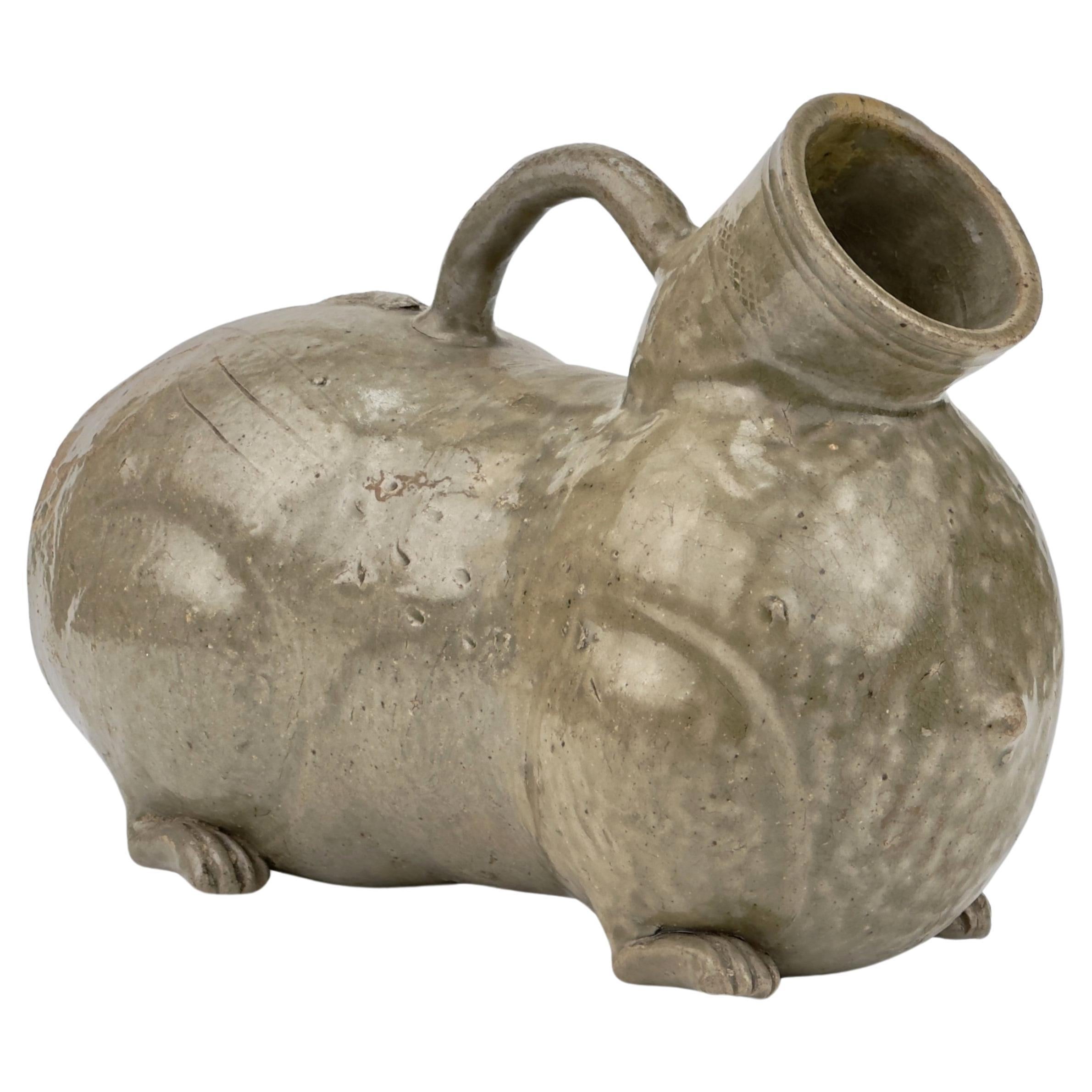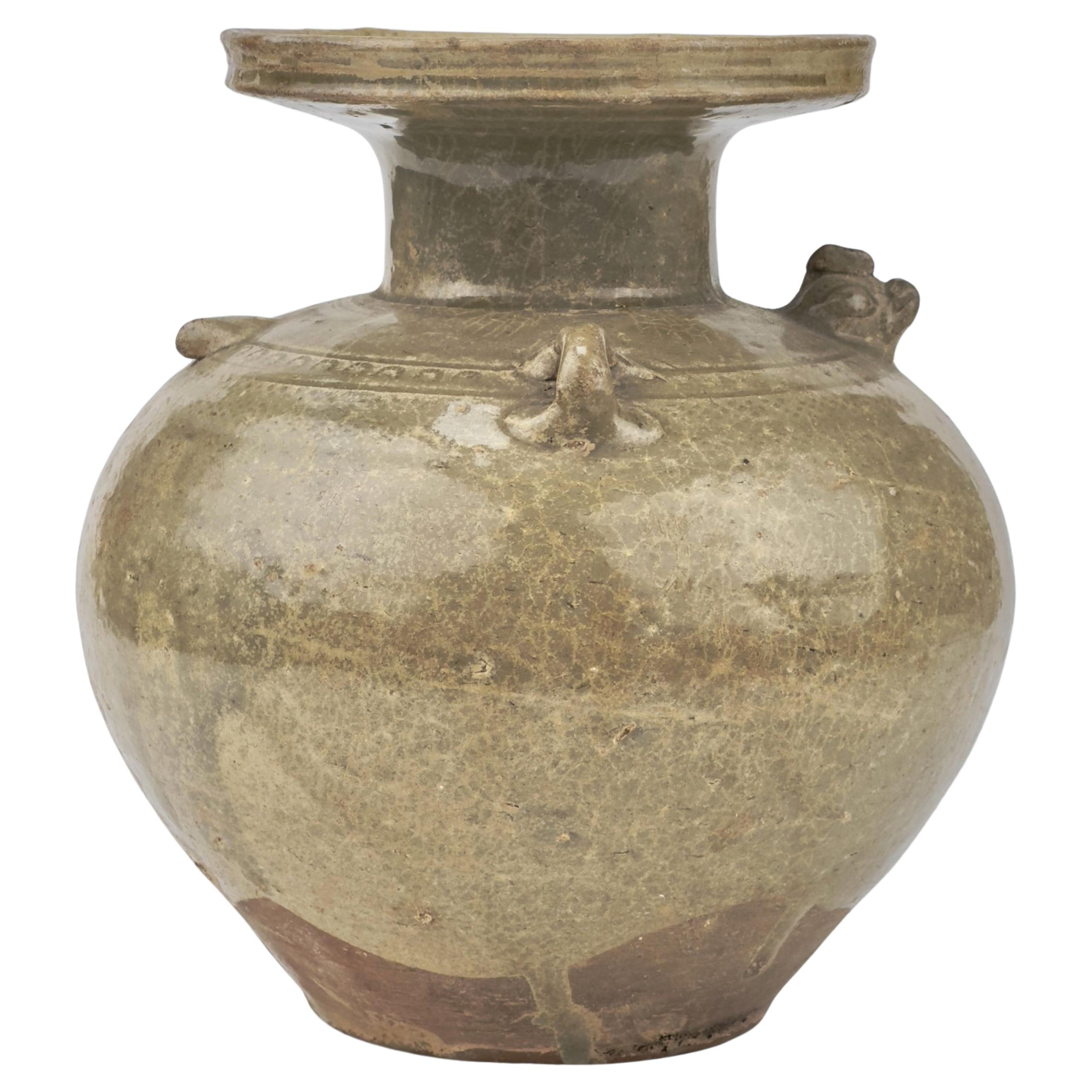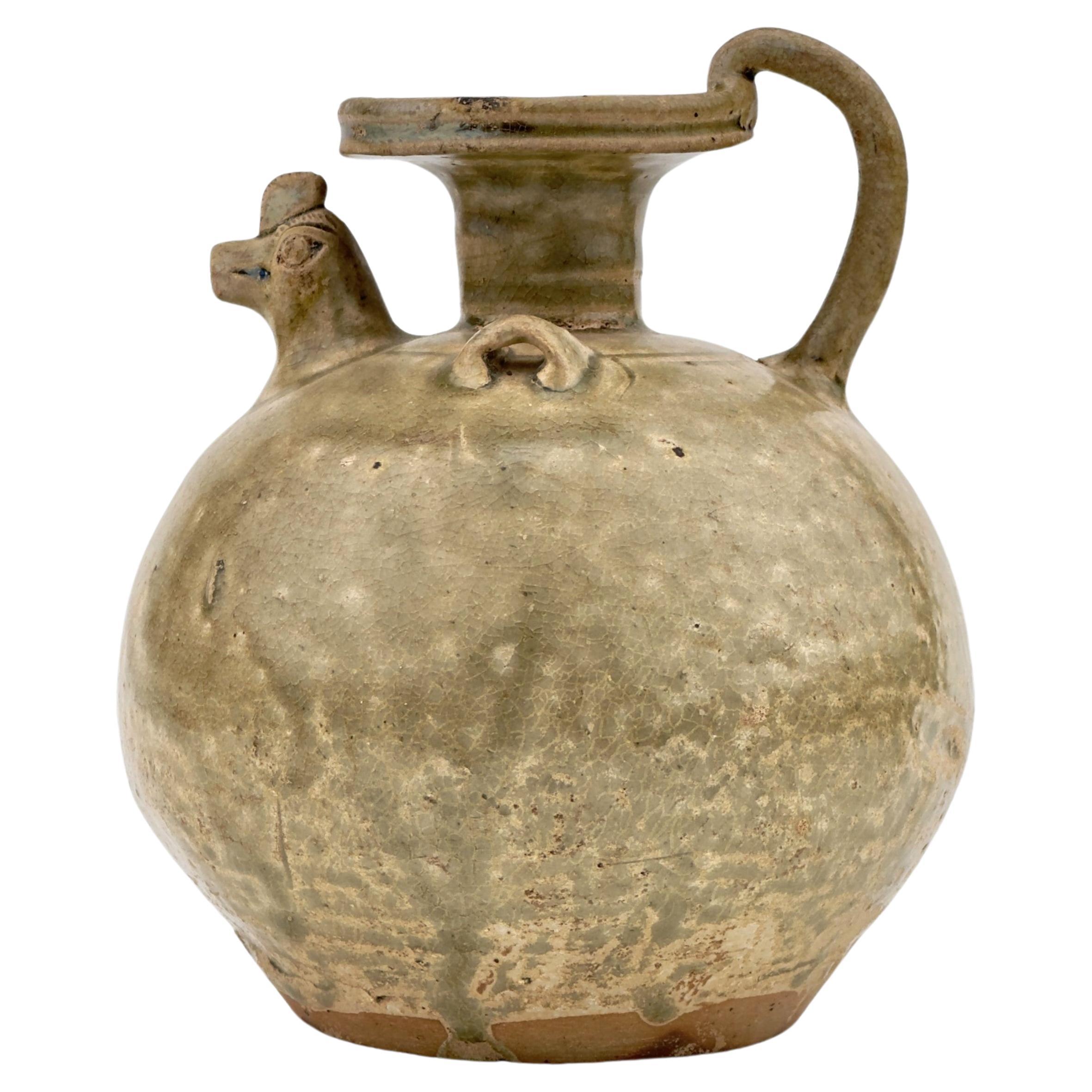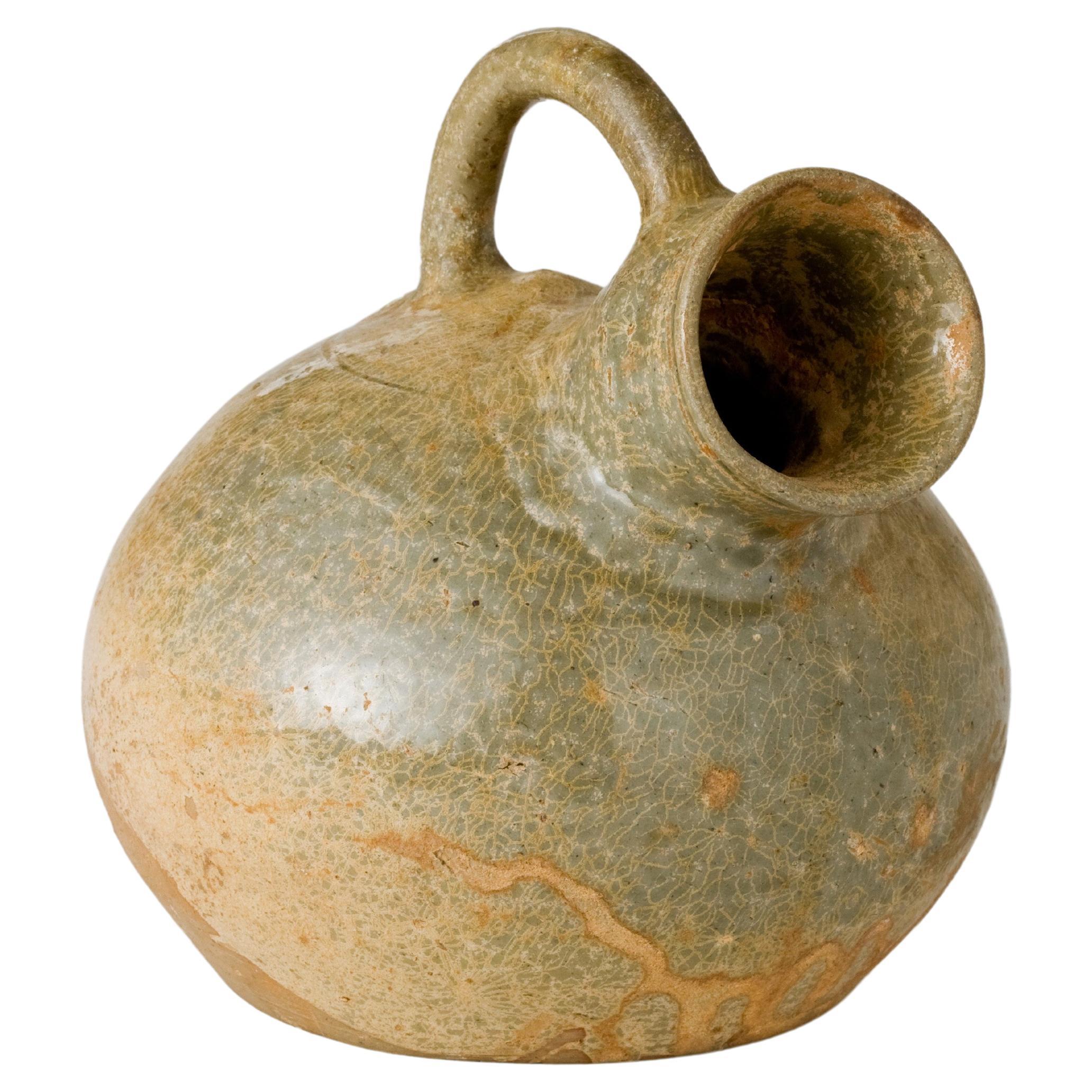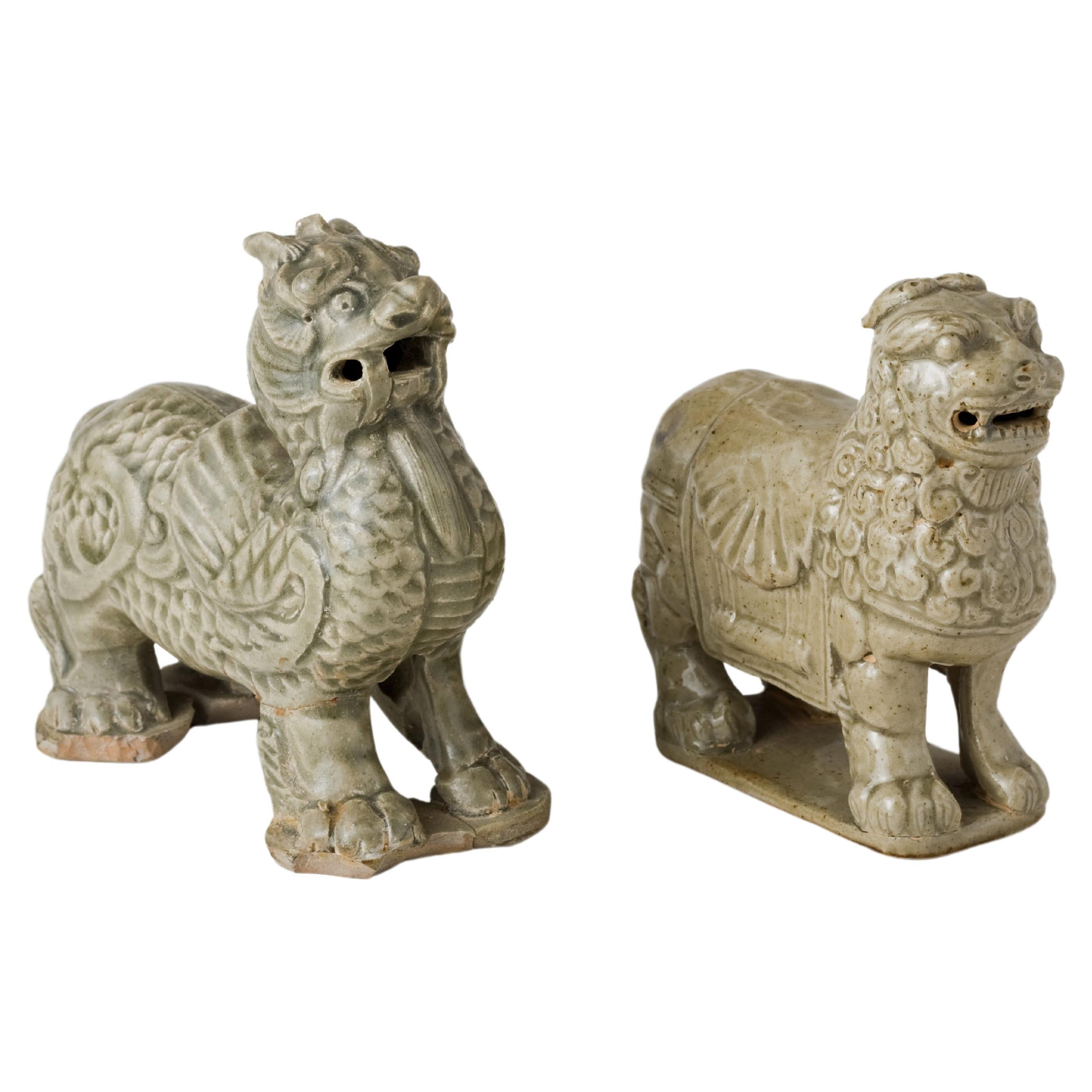Items Similar to Rare Boshan Incense Burner Yue Celadon, Jin dynasty
Want more images or videos?
Request additional images or videos from the seller
1 of 21
Rare Boshan Incense Burner Yue Celadon, Jin dynasty
About the Item
The Boshan incense burner is particularly notable among Han dynasty incense burners for its unique shape. Designed to resemble a mountain or even a mythical mountain, it is characterized by its pointed peaks that rise upwards. These peaks often function as vents for the smoke, creating an effect reminiscent of a volcanic eruption.
The body of the incense burner is typically round, with multiple small peaks surrounding a central, larger peak. The material used is mainly ceramic, although there are instances where they were made of bronze. It is presumed that this incense burner was used for religious or ceremonial purposes during its time. The colors of these burners are usually in shades of pale green or greyish brown, with the application of glaze to achieve a variety of colors on occasion.
Such incense burners are often found in tombs or ritual sites, and their purpose was to burn incense for purification of space or to produce pleasant aromas. The Boshan incense burner also represents a significant cultural heritage, showcasing the craftsmanship and artistic values of the period. Today, it is considered a quintessential example of ancient Chinese art.
Period : Han-Jin Dynasty
Type : Incense Burner
Medium : Yue celadon(Stoneware)
Size : 17cm(Height), 12cm(Diameter)
Provenance : The piece was acquired in Hong Kong in the year 1999.
Condition : Good
Reference :
1) Smithsonian National Museum of Asian Art, Washington D.C. - ACCESSION NUMBER:S2012.9.3624a-b
2) National Museum of China
3) The Museum of East Asian Art, China
* Boshan and Eastern Culture
The Boshan incense burner’s design, which mimics a mountain, is especially symbolic. Mountains have long been considered sacred in Chinese culture, representing closeness to the heavenly realm. They are often depicted as the abode of immortals and deities. The mountain-shaped Boshan incense burner serves as a microcosmic representation of these holy mountains, with the smoke mimicking cloud and mist surrounding the peaks, enhancing the sacred ambiance during rituals.
In Confucianism, another significant aspect of Chinese culture, ritual and ancestor worship are central. Incense burners were used in ancestral rites to honor and remember the deceased. The pleasing aroma of incense was believed to summon the spirits of ancestors, allowing the living to pay their respects and seek guidance or blessings.
The Boshan incense burner would have been an important object in burial practices as well. Placed in tombs, they served both as items for the afterlife and as a means to provide a fragrant journey for the departed to the afterlife. This reflects the ancient Chinese belief in an ongoing relationship between the living and the dead.
The artistic and functional aspects of the Boshan incense burner reflect the fusion of spiritual symbolism, cultural practices, and the sophisticated aesthetic values of the time. It stands as a testament to the importance of incense in ritualistic practices and the broader cultural and religious landscape of ancient China.
- Dimensions:Height: 6.7 in (17 cm)Diameter: 4.73 in (12 cm)
- Style:Han (Of the Period)
- Materials and Techniques:
- Place of Origin:
- Period:
- Date of Manufacture:2th-4th Century
- Condition:Minor fading. Various minor scratches. It was confirmed that few of the horns had been repaired a very long time ago and had become discolored.
- Seller Location:seoul, KR
- Reference Number:1stDibs: LU9577238612172
About the Seller
New to 1stDibs
Joined in the past six months.
4.5
Vetted Seller
These experienced sellers undergo a comprehensive evaluation by our team of in-house experts.
Established in 1999
1stDibs seller since 2023
Typical response time: <1 hour
- ShippingRetrieving quote...Ships From: seoul, Korea South
- Return PolicyA return for this item may be initiated within 10 days of delivery.
More From This SellerView All
- Rare Yue Celadon-Glazed Vessel, Jin dynasty (265-420)Located in seoul, KRA Yue celadon vessel from the Jin Dynasty period, notable for its characteristic greenish-glazed pottery which was prominent during this time. The vessel features a globular body wit...Category
Antique 15th Century and Earlier Chinese Han Antiquities
MaterialsStoneware
- Rare Yue Celadon Chicken-Head Ewer, Jin-Southern DynastyLocated in seoul, KRChicken-head ewers are among the most distinct and emblematic pottery pieces from the dynamic yet innovative era spanning from the Han (206 BC - AD 220) to the Tang (618~907) dynasti...Category
Antique 15th Century and Earlier Chinese Han Antiquities
MaterialsCeladon, Stoneware
- Rare Yue Celadon Chicken-Head Ewer, Jin-Southern DynastyLocated in seoul, KRChicken-head celadon is among the most distinct and emblematic piece from the dynamic yet innovative era spanning from the Han (206 BC - AD 220) to the Tang (618-907) dynasties. Thei...Category
Antique 15th Century and Earlier Chinese Han Antiquities
MaterialsCeladon
- Rare Yue Celadon-Glazed Figural Vessel, Western Jin dynasty (265-420)Located in seoul, KRThis vessel is well-modeled as a recumbent winged lion with detailed decorative elements. It features a grimacing face with large protruberant eyes under heavy brows and a gaping mou...Category
Antique 15th Century and Earlier Chinese Han Antiquities
MaterialsCeladon
- A Rare 'Yue' Celadon Glazed Octagonal Vase, Western Jin Dynasty (266 - 316 AD)Located in seoul, KRFinely potted with incurved facetted sides divided by raised ribs and set with two short lugs to the shoulder, the body rising to a short octagonal neck, the domed cover of conforming section, surrounded by an upturned rim and surmounted by a bud finial, applied overall with a celadon glaze of the period. A related vase of this rare and charming form, in the Zhenjiang Museum, Zhenjiang, is illustrated in the Complete Collection of Chinese Ceramics. Song, vol. 8, Shanghai, 1999, pl. 52. Vases of related octagonal shape were produced at the Ding kilns, in Hebei province, and the qingbai kilns in Jiangxi province; see a Ding vase in the Palace Museum, Beijing, illustrated in Selection of Ding Ware. The Palace Museum’s Collection and Archaeological Excavation, Beijing, 2002, pl. 37; and a qingbai example, from the Meiyintang collection, illustrated in Regina Krahl, Chinese Ceramics from the Meiyintang Collection, vol. 3 (II), London, 2006, pl. 1590; and another carved with a floral scroll, included in the exhibition Song Ceramics from the Kwan Collection, Hong Kong Museum of Art, Hong Kong, 1994, cat. no. 105. Period : Western Jin Dynasty (266 - 316 AD) Type : Octagonal Vase Medium : Yue celadon...Category
Antique 15th Century and Earlier Chinese Han Antiquities
MaterialsCeladon
- Rare Yue Celadon-Glazed Two Haitai Statues, Western Jin dynasty (265-420)Located in seoul, KR* Set item(Two statues) The statue on the left seems to be a mythical beast standing in a poised and alert stance, with its mouth open as if roaring or breathing fire. Its body is covered in detailed carvings that resemble scales and feathers, indicative of the high level of craftsmanship during the Jin Dynasty. The creature’s presence is both regal and intimidating, suggesting it might have been believed to possess protective properties. The statue on the right presents a more stoic and solid stance, with a broad chest and a upright head. Its facial expression is stern, with deep-carved eyes and an open mouth that reveals its teeth, adding to its majestic and formidable appearance. The mane and other body features are intricately detailed, suggesting a high level of artistic skill in its creation. Period : Western Jin Dynasty (266 - 316 AD) Type : Haitai Statue Medium : Yue celadon...Category
Antique 15th Century and Earlier Chinese Chinese Export Antiquities
MaterialsCeladon
You May Also Like
- Rare Chinese Antique Bamboo Incense Burner, Qing periodLocated in Chuo-ku, TokyoThis is a rare ding-shaped incense burner using bamboo. Ding (鼎) is a tool used in ancient Chinese magical rituals, and while bronze ware is common, this ...Category
Antique 17th Century Antiquities
MaterialsBamboo
- White Porcelain Incense Burner / Korean Antique / Joseon Dynasty/1392 - 1897 CELocated in Kyoto-shi, KyotoThis incense burner presents the characteristics of a typical Yi Dynasty Joseon Dynasty incense burner with a body that rises smoothly from the base, openworked ears and a semi-circu...Category
Antique 17th Century Korean Antiquities
MaterialsCeramic
- Korean Celadon Ritual Incense Burner Joseon DynastyLocated in Atlanta, GAAn antique Korean ritual incense burner circa 19th century (late Joseon dynasty). This type of porcelain incense burner was made in Bunwon Kiln in Gwangju, Gyeonggi Do, near Seoul. U...Category
Antique 19th Century Korean Archaistic Ceramics
MaterialsCeramic
- Celadon Incense Burner with Peony Arabesque Design/Chinese Antique/14th-17th CLocated in Kyoto-shi, KyotoThis is a Celadon three-legged incense burner with peony arabesque design. Since the 14th century, Dwarf sedge was planted in this pot to decorate the tea room, so in Japan it is ...Category
Antique 15th Century and Earlier Antiquities
MaterialsCeramic
- Chinese Bronze Incense Burner or CenserLocated in Los Angeles, CAChinese Bronze Censor believe to be from the 1800's. The pice is very substantial and heavy - the lid removes to reveal a solid bronze platform for incense. A wonderful piece and hig...Category
Antique 19th Century Chinese Antiquities
MaterialsBronze
- White China Fenix Figured Incense Burner, Edo PeriodLocated in Chuo-ku, TokyoIncense burner with three-dimensional molding of Hirado ware(Origin in Hirado, Nagasaki prefecture) of the Edo period. Hirado ware is very famous for it...Category
Antique 18th Century Japanese Antiquities
MaterialsPorcelain
